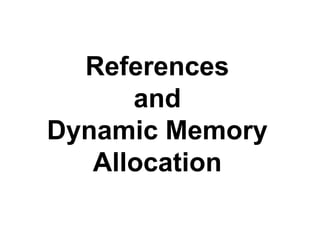This document discusses references and dynamic memory allocation in C++. It covers passing references as function parameters, returning references from functions, and advantages over pointers. It also explains static versus dynamic memory allocation, allocating and deallocating single and multi-dimensional dynamic arrays, and avoiding memory leaks when using dynamic allocation.







![Function returns a reference to the a[n] array
const int SIZE = 6;
element.
int & put_val(int a[], int n){
if(n>=SIZE || n<0){
cout<<“Out of boundaries”; exit(1);
}
return a[n]; } OUTPUT:
array[0] = 0
array[1] = 2
// put_val(array, i) = i *2;
array[2] = 4
// array[I] = i *2;
array[3] = 6
array[4] = 8
int main(){ array[5] = 10
int array[SIZE];
for(int i=0; i<SIZE; i++)
put_val(array, i)=i*2; //function call on the left
for(int j=0; j<SIZE; j++)
cout<<“array[“<<j<<“] = “<<array[j]<<endl;
}](https://image.slidesharecdn.com/chp4refdynamic-111020021031-phpapp01/85/Chp4-ref-dynamic-8-320.jpg)


![STATIC VERSUS DYNAMIC
• STATIC MEMORY ALLOCATION - fixed size array to allocate
memory.
• An amount of memory allocated - reserved when the program is loaded
into memory.
• Could fail if run on comp. system lack enough memory.
struct comp_part{
char code[7];
char description[30];
int on_stock;
int sold;
float price;
};
comp_part list[100];](https://image.slidesharecdn.com/chp4refdynamic-111020021031-phpapp01/85/Chp4-ref-dynamic-11-320.jpg)



![• Dynamically allocated array - variable size.
• Allocate single-dimensional dynamic array:-
Pointer_var = new data_type[size];
• Deallocate single-dimensional dynamic array:-
Delete []pointer_var
• Eg.:-
int *ptr;
ptr = new int[10];
for(int i=0; i<10; i++)
ptr[i] = (i+1)*2;
delete []ptr;](https://image.slidesharecdn.com/chp4refdynamic-111020021031-phpapp01/85/Chp4-ref-dynamic-15-320.jpg)
![•Allocate two-dimensional dynamic array:-
data_type **pointer_var;
pointer_var = new data_type *[size];
•Deallocate two-dimensional dynamic array:-
as shown in paper.](https://image.slidesharecdn.com/chp4refdynamic-111020021031-phpapp01/85/Chp4-ref-dynamic-16-320.jpg)